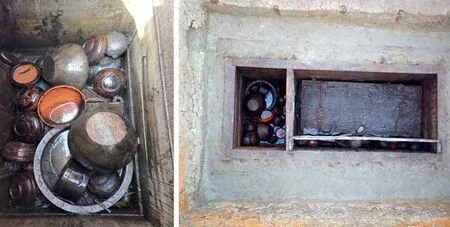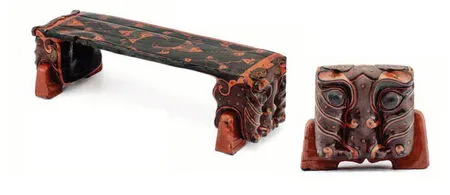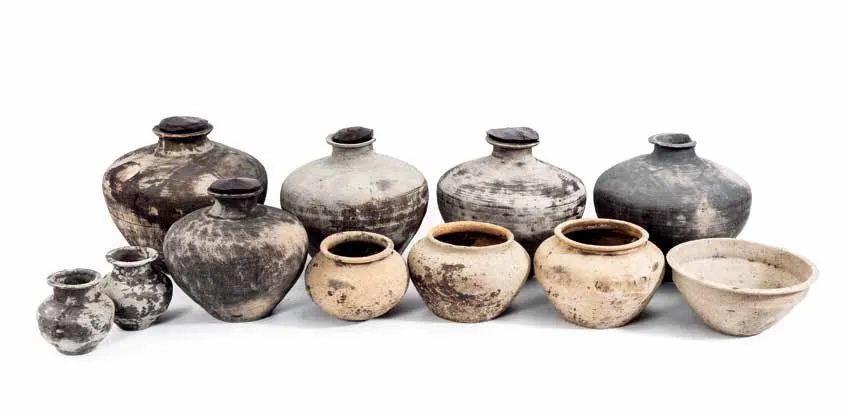Zhengjiahu Graveyard:Cultural Fusion
2022-07-27TextbyZhangJingwen
Text by Zhang Jingwen
Photos courtesy of Hubei Provincial Institute of Cultural Relics and Archaeology
The excavation of the Zhengjiahu graveyard site has provided a wealth of information on the war launched by the Qin State more than 2,000 years ago,which promoted the unification of the Chinese nation.

The longest gu ever found in China.The text on the long gu tells a story about a political strategist named Tu who accepted an appointment of the King of Chu and went to the Qin State to persuade the King of Qin to “stop the war and stand up for justice.”
D uring the late Warring States Period (475-221 B.C.),Qin State(in today’s Shaanxi Province) general Bai Qi conquered Ying,capital of the Chu State in 278 B.C.,forcing the Chu royal family to move eastwards.For many years thereafter,the Yunmeng area (around the former capital of Chu) was the site of conflict between Qin and Chu.More than half a century of war resulted in the decline of Chu and thousands of untold human tragedies.Two thousand years later,excavation of the site of the former capital of Chu has revived memories buried in the land.
China’s Longest Gu
One day at the end of September 2021,archaeologists discovered a pile of small wood pieces at the excavation site of the Zhengjiahu graveyard in Yunmeng County,Hubei Province.Cleaning gradually revealed words on the wood pieces.Upon seeing them,Luo Yunbing,head of the archaeological team and deputy director of the Hubei Provincial Institute of Cultural Relics and Archaeology,immediately sent those wood pieces to the cultural relics protection center.Among them,one particular wooden(a kind of wooden or bamboo slips used for writing) caught the attention of experts.

An overview of an unearthed coffin and its head compartment.
Generally,thehas a polygonal body with three sides,and characters can be written on each side.According to Luo,this longis somewhat special.It is a log cut in half.“The characters on it are typical official scripts of the Qin State,and the full text is nearly 700 characters.As the earliestwith the most abundant content,it is indeed the longestin China.”
The text on the longtells a story about a political strategist named Tu who accepted an appointment of the King of Chu and went to the Qin State to persuade the King of Qin to “stop the war and stand up for justice.” This story had not been found in previous historical records,and it provides new materials for modern people to discuss the societal trends of the time.
“This longwas unearthed from a Qin tomb,” said Luo.“According to its size,the tomb probably belonged to a lowerlevel official in the Qin State,which was powerful at that time.However,suffering from endless wars,the Qin people longed for peace as did people in the other six states.This longexpressed the wish of the tomb owner that the wars would end as soon as possible,even though that position was against the King of Qin at that time.The discovery of this longwas a surprise,and more importantly,it verified that our method of excavating while protecting and researching is scientific and effective.”
May 2020 to present
Chengguan Town,Yunmeng County,Hubei Province
Warring States Period
150,000 square meters
Rated as one of China’s top 10 new archaeological discoveries in 2021
Blend of Cultures

Archaeological researchers conduct multi-disciplinary testing.
The Zhengjiahu graveyard site was listed as one of China’s top 10 new archaeological discoveries in 2021,not only due to the exquisite cultural relics unearthed,but more importantly because it provided evidence for China’s progress towards a unified country after Qin conquered Chu back then.
From May 2020 to December 2021,the archaeological team discovered 196 Chu tombs and 108 Qin tombs in the area.The tomb cultures of the Qin and Chu states are quite different in terms of scale,coffin structure,combination of burial objects,and sacrificial customs.However,the archaeological team found considerable evidence of a gradual blending of tomb cultures of the two states.
The paintings on wooden burial utensils unearthed from Qin tombs are a typical example of the deep integration of Qin and Chu cultures.The compatibility and absorption of Chu culture by the Qin people can be seen in the themes of those paintings.“We found distinctive signs of Qin culture in these paintings such as flat pot patterns and leaf patterns on sacrificial vessels,”said Luo.“The crane images are also very prominent,which is probably a sign of influence from Chu culture.”

A lacquered wooden headrest featuring tiger patterns unearthed from the Zhengjiahu graveyard site.

Pottery combinations unearthed from the Zhengjiahu graveyard site.
In other tombs,traces of integration of Qin and Chu cultures can also be found.In the tomb of a woman,the funerary pottery was mainly in the Qin style,but archaeologists found a typical Chu-style pottery ware with a round bottom and double ears.“She might have been a descendant of local Chu people who married a Qin man later and was buried in the cemetery after her death.Therefore,her tomb features the influence of Qin culture while retaining a bit of Chu cultural tradition.”
Evidence of Integration
In September 2021,the discovery of a cluster of saturated tombs surprised the archaeological team.In these tombs,gaps in utensils are filled with water,so they maintain a relatively original shape and appearance.Therefore,not only are funerary objects and coffins well preserved,but also important information related to things like human bones,sacrificial animals,and food.
The excavation team extracted information about isotopes in precipitation from 12 human bones which generally showed the diet changes and migration routes in their lives.The migration routes of the owners of these tombs represent the general trend of national integration at the end of the Warring States Period.“Through a variety of stable isotope tests,we found that among the 12 people,five were born in the rice-growing area in the south and seven in the dry farming area in the north.A total of nine individuals engaged in long-distance migration.”
“The tomb No.M257 is the highest-level tomb in the whole Zhengjiahu graveyard site,”continued Luo.“Based on its daily pottery combination,way of burial,and sacrificial customs,it is likely that the tomb owner was a Qin person from the northwest.” He said that according to the stable isotope data,the tomb owner was born in the dry farming area in the northwest but came to the Jianghan Plain of the former Chu State in his youth and spent the rest of his life there.They found three bronze swords placed on both sides of the tomb owner’s skeleton.Scars on the blade indicate that he might have been a warrior or general who fought for many years.Archaeological typology analysis and carbon-14 dating data showed that the tomb owner died and was buried during the Qin Dynasty(221-207 B.C.).Based on this data,he fought for the unification of China as a Qin warrior for at least 20 years.
The excavation of the Zhengjiahu graveyard site has provided a wealth of information on the war launched by the Qin State more than 2,000 years ago,which promoted the unification of the Chinese nation.
